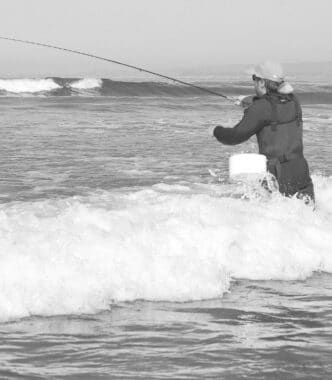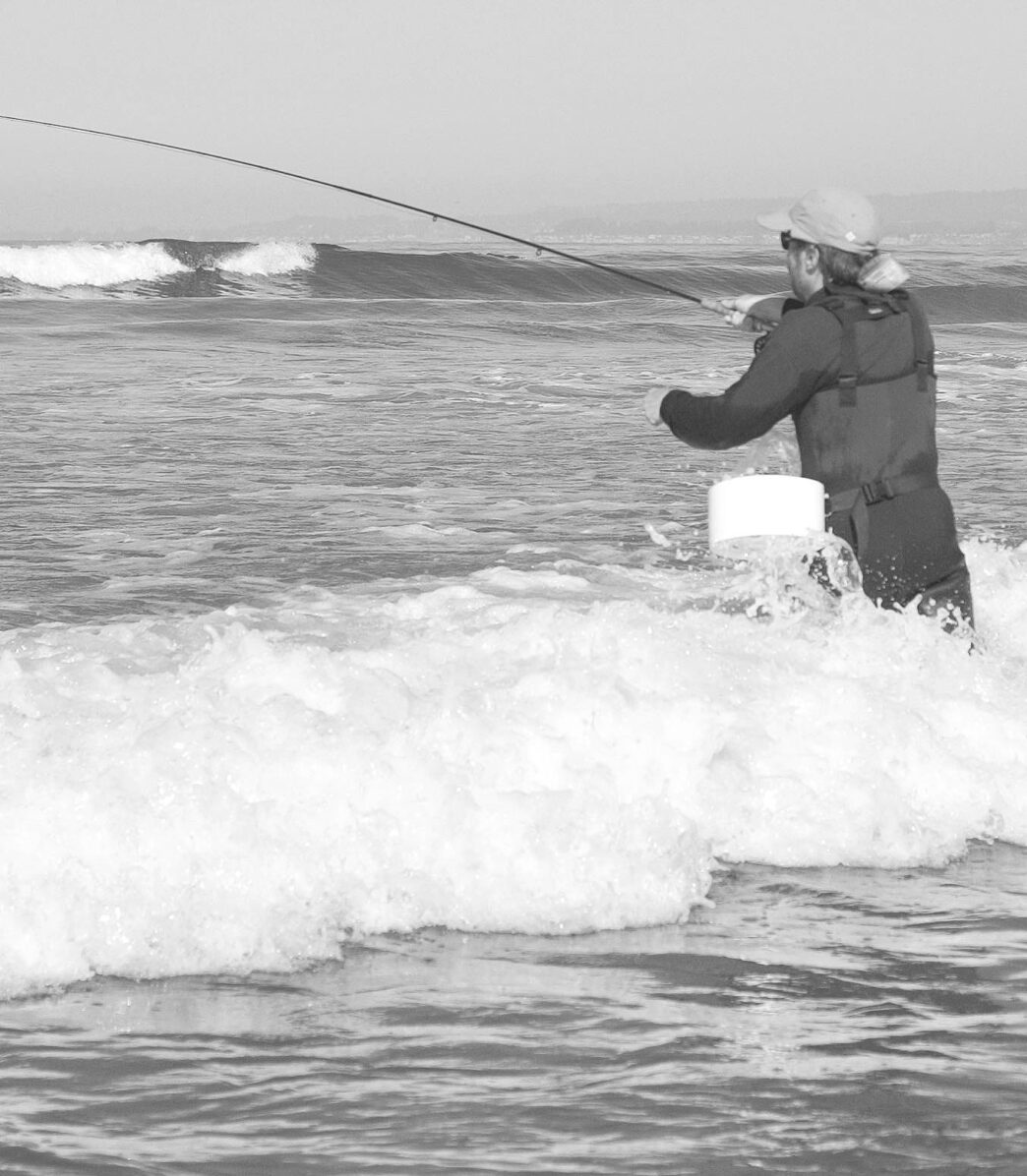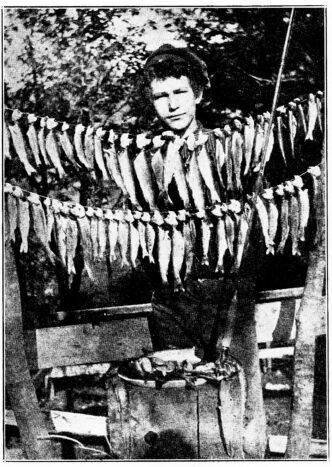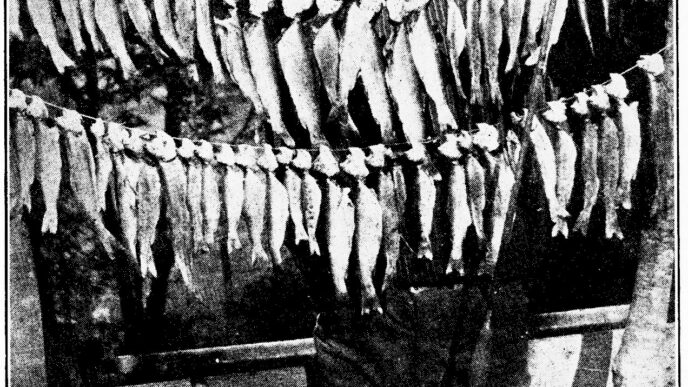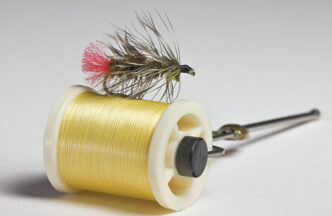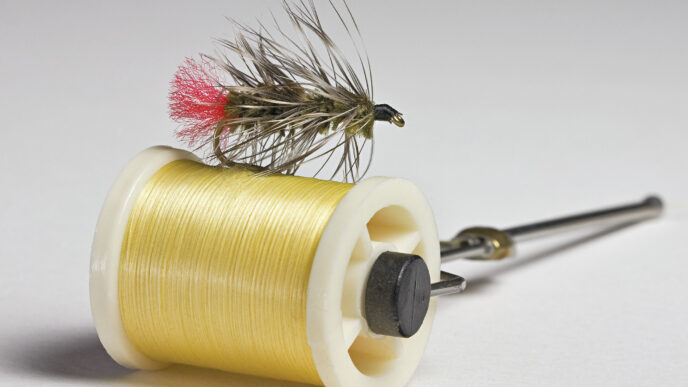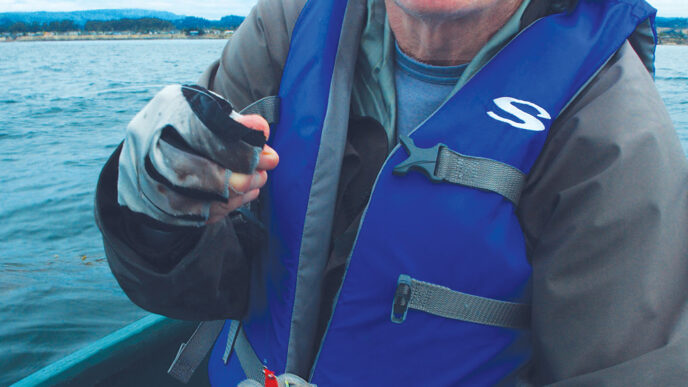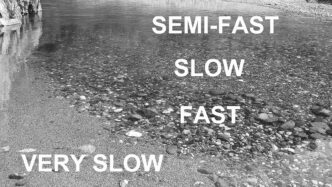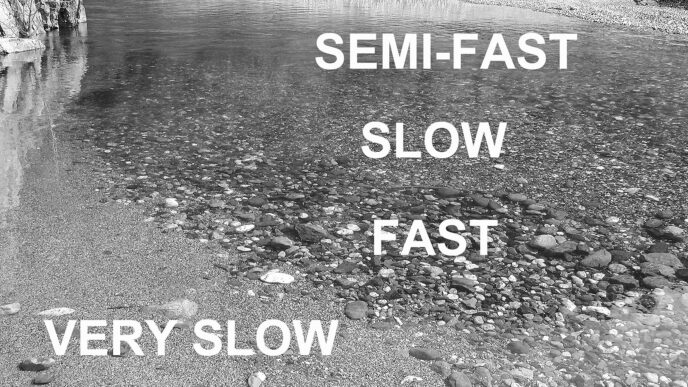As you look down a California beach, it’s easy to distinguish fly fishers from the regular bait-and-hardware guys. The fly fisher is almost always adorned with that distinctive fashion accessory, the stripping basket. Belted to the waist and carried sidearm, belly first, or sometimes slipped to the back, a stripping basket is hard to miss. No one would call them elegant, though a few do have a certain abstract sculptural charm. Some folks choose to buy their baskets “off the rack,” while others go the do-it-yourself route. Ultimately, they all have the same purpose — to store line in between casts and release it during the cast as cleanly as possible.
Hand-Jive Line Management
Back in the 1980s, the majority of fly fishers who ventured into Monterey Bay’s suds did so without a stripping basket. When I say “the majority,” I mean the half dozen or so people I met somewhat regularly. Fly fishing the surf was not a popular sport back then. These anglers would strip the line carefully into the water using currents to pull it away from their legs. The masters of this t’ai chi–like art are Ken Hanley and Jay Murakoshi. Watching these two guys work the surf is quite a sight. They snap out casts to the edges of rips, troughs, and seams, and during their clinical retrieves, their arms move with the grace of a Las Vegas blackjack dealer. For many years, this dynamic duo taught hundreds of anglers how to fly fish the surf zone effectively without a stripping basket.
I tried fishing this way, but was never able to master the subtle art of line management. The line inevitably tangled around my feet or would get hung up on some weed. It was clear that I needed a basket if I was going to fish the suds successfully. But what type of basket was best suited to the job? Twenty-five plus years and countless DIY basket projects later, I am getting closer to the ideal stripping basket.
Commercial Baskets
Many fly fishers have neither the time nor the interest to make their own stripping basket. These folks simply purchase something through a tackle store or online. Based on what I see parading up and down the central California coastline, the most popular models are from Orvis and Mangrove Outfitters. The Orvis basket is a hard plastic device contoured to fit snugly against the torso. It is essentially a high-tech version of a plastic dishpan. Inside the tray is a series of raised cones, which are intended to reduce tangles. A thick nylon strap runs through slots in the basket and is secured to the waist by a plastic clip. According to the manufacturer’s blurb, students at MIT designed this basket. It certainly works. The cones inside the tray do seem to reduce line tangles by restricting the lateral movement of line in the tray. The basket also provides two handy cutout slots so you can lay your rod in it while fussing with terminal tackle or taking a breather. My buddy Steve Rigg swears by his Orvis stripping basket.
The Mangrove Outfitters Hipshooter stripping basket was originally invented by Californian Stan Pleskunas. Stan came up with the design in the early years of this century and provided several committed surf fly fishers with prototypes to try out. Stan and Dave Sellers conducted most of the design work and field testing in the Monterey Bay surf. I still have the remains of one of Stan’s prototypes.
The beauty of this product is its lightweight, soft-foam construction. The basket simply clips onto your belt and can be slid to the side or front, depending on which alignment you prefer. Being foam, it provides a soft edge, which can be really helpful when you have cold hands and are stripping hard. Slamming the back of cold fingers into hard plastic can be painful. This basket breaks down into readily packable pieces, which makes it great for folks who travel and want to take a stripping basket with them. The one downside of this portability is that a wave can sometimes knock out the unsecured base. The simple solution is to lock the base in place with a few stainless steel screws. The belt clip can also be a little loose. You can remedy that with a pair of pliers or by using a thicker belt.
For a number of years, L. L. Bean produced a good basket. This hard plastic kidney-shaped bowl fitted nicely against the waist. It featured internal cones, like the Orvis basket. Many fly fishers felt this was a superior basket, and it may be worth shelling out a Jackson or two if you come across a gently used one.
A relatively recent arrival to the basket market is the Flexi-Stripper. This design is based on a flat plastic tray armed with soft nylon spikes. The simple gizmo attaches to your leg or waist with a belt. You simply lay your line into the nylon spikes, which trap the loose coils in place. During the cast, the spikes release the line in a well-controlled manner. The FlexiStripper seems to work quite well when fishing from a boat or wading in still waters and is considerably less bulky than more conventional designs. Unfortunately, the lack of sides makes it of limited value for fly fishers wading in the suds. It takes only one wave for the line to get knocked off the spikes and start curling around your legs like a snakes in a horror flick.
Fabric baskets have been around for quite some time. They are light and packable, and for freshwater fly fishers, they are probably ideal. Unfortunately, the same cannot be said for their utility in the surf. They tend to have one major flaw: flexibility. Nothing tangles a fly line more quickly than waves smashing into a basket and throwing the line into a jumble. The other problem with fabric baskets is they tend to get wet and droopy, at which point they spill line into the water. No surf-zone fly fisher I know has used a fabric basket for more than one trip.
DIY Basket Evolution and Design
Surf-zone fly fishers can be a rather unconventional breed. Maybe it’s genetic. Who knows? Whatever the reason, they often blaze their own trail with unconventional fishing techniques and gear. Stripping baskets are one of the pieces of kit that provides a great way for this group to fly its freak flag. Whenever I see a fly fisher waddling down the beach, the first thing I check out is the basket. The variety of designs and materials is fascinating.
This experimenting has been going on for quite some time. In the 1980s, East Coast surf-zone fly fishers popularized stripping baskets based on plastic dishpans attached to the waist using bungee cords. This utilitarian setup was featured in numerous magazine pictures. It provided a low-cost line-management system with ample space for 100-plus feet of line. When drilled to provide drainage and fitted with stiff mono whiskers to reduce line tangling, it was a very serviceable setup. You could even pimp the thing by slapping a few bumper stickers on the side. Some successful commercial baskets, such as the Orvis model, are only one or two evolutionary steps removed from the dishpan.
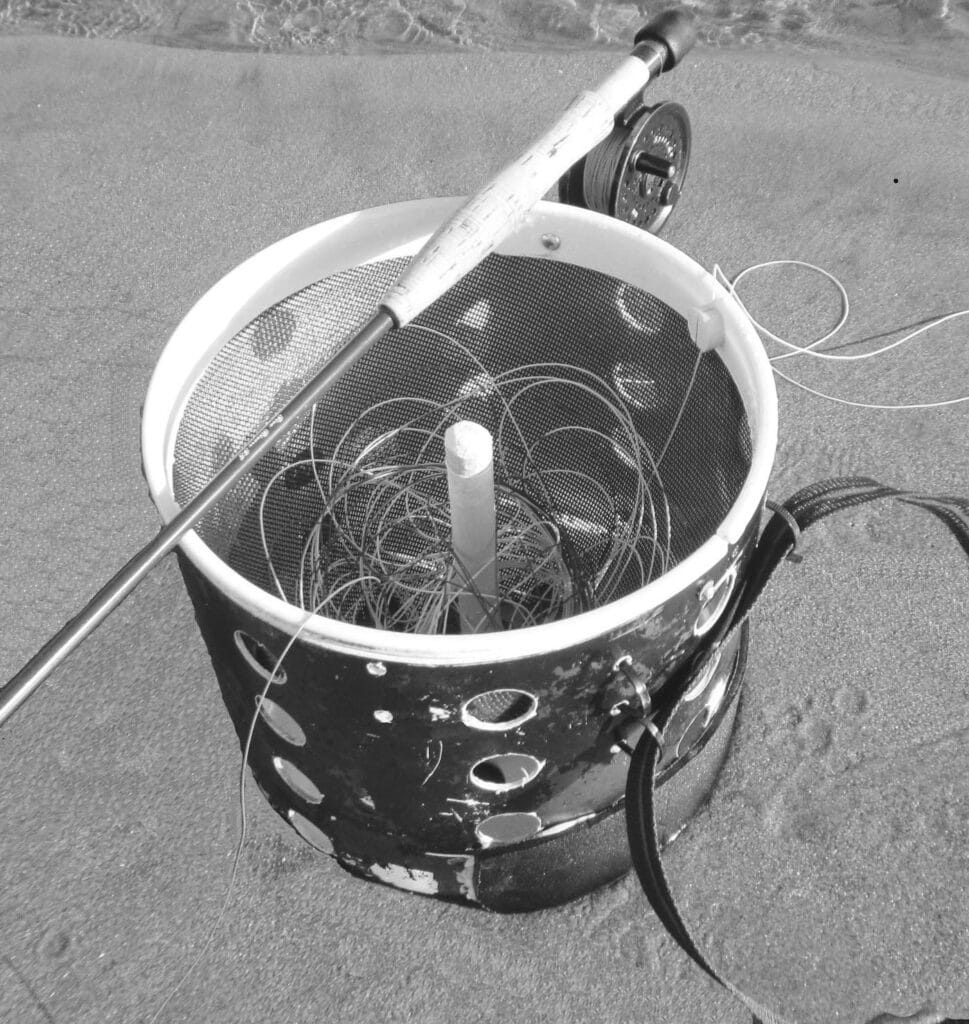
My experiments with this platform showed the design to be quite serviceable for Left Coast use, too. The main drawbacks were that the shallow depth and ample width made them prone to bending and spilling line whenever a wave dumped into the basket. The bungee cord was also a bit of a safety hazard. The last thing you want to be doing when knocked down in the surf is trying to unhook a dishpan from your waist.
The undersink-style plastic kitchen waste bin was also popular for a short while. The 20-inch-plus depth of this container meant the bottom was at or below knee height. Being low slung, it was prone to getting knocked around by waves, even in small surf. The continuous jostling often resulted in line tangles. At 20 to 30 quarts of volume, this setup also tended to be extremely heavy when filled by the occasional, yet inevitable overtopping wave. Not surprisingly, you seldom see anyone using this setup anymore.
Perhaps the most common DIY setup is based on plastic organizers or shopping baskets. These provide excellent drainage and a relatively rigid form. Armed with nylon zip tie or rigid mono spikes in the
base, they have served many people well. I have a garage full of old models based on this design. Smaller 12-by-9-inch baskets are light and don’t feel cumbersome when strapped to your body. With some judicious use of plastic or aluminum stiffening rods to beef up weak sidewalls, they can be quite durable. They don’t hold much line, though. If you don’t need to fish much beyond 70 feet, this type of basket is fine. Beyond that, you really need to step up to a larger platform, such as the grocery store basket. In addition to its extra volume, the grocery store design also has the advantage of being very robust. The basket is designed to survive the mercenary abuse of thousands of shoppers and has engineered structural elements that make it rigid, yet still relatively light. A basket built on this platform can be considered almost indestructible. About the only downsides with this design is that they are bulky, and unless you buy one (they can be found on eBay for $8 to $12), possession is likely the result of criminal activity. California Fly Fisher does not condone shoplifting.
The Gut Bucket
About 10 years ago, I started experimenting with designs based on a four-gallon bucket. I found that the shopping-basket-based designs, while workable, were simply too cumbersome for me. I wanted something that could accommodate 100-plus feet of line while not feeling like I had a garbage dumpster lashed to my hip. The initial design was a bucket with the top half cut off. This provided a circular two-gallon container. With holes drilled in the base and sides and a web belt attached through zip-tie loops, the system worked quite well. I experimented with a variety of line-taming devices glued to the base, including bottle-rocket tops, a single central cone, and even golf tees. I also experimented with remodeling one side of the bucket so that it was concave and would fit more closely to my waist. Like all other designs, the gut bucket still had problems with line tangles. Tangling is the Achilles heel of the stripping basket. Tangles mean lost fishing time and even lost fish. This was not an acceptable status quo as far as I was concerned.
Floppy Loops
In the summer of 2008, I decided it was time for me to get serious about the tangling problem. I turned my attention to the behavior of the line in the basket. At first it was tough to make out anything from the mass of coils. Tangles happened, but the line moved so fast that I could not really see what was causing them. Then, after an hour or so, I started to notice something. It was a subtle characteristic of line behavior I had not heard anyone mention before. In hindsight, it should have been obvious.
If you look closely at your line as you strip it into the basket, you may notice that not all loops of line lie down flat. Some will settle into a nearly vertical alignment. Typically, those loops rest against the side of the basket or more precariously on top of adjacent sections of line. I noticed that occasionally, these raised loops became unstable and flopped over. The flopped loops were now lying out of sequence with the rest of the shooting line and were trapping line that had been stripped in later in the retrieve. On the next cast, the flopped loop then lifts up from the basket prematurely. It responds by forming a loose loop knot with the line on top of which it had flopped. As this mess exits the basket, it tightens, and the result is our friend, the curse-invoking tangle. It was obvious that if I was going to reduce line tangling, I had to find a solution for this malady. James Lind cured scurvy; Edward Jenner cured smallpox; my lot was to find a cure for floppy loops.
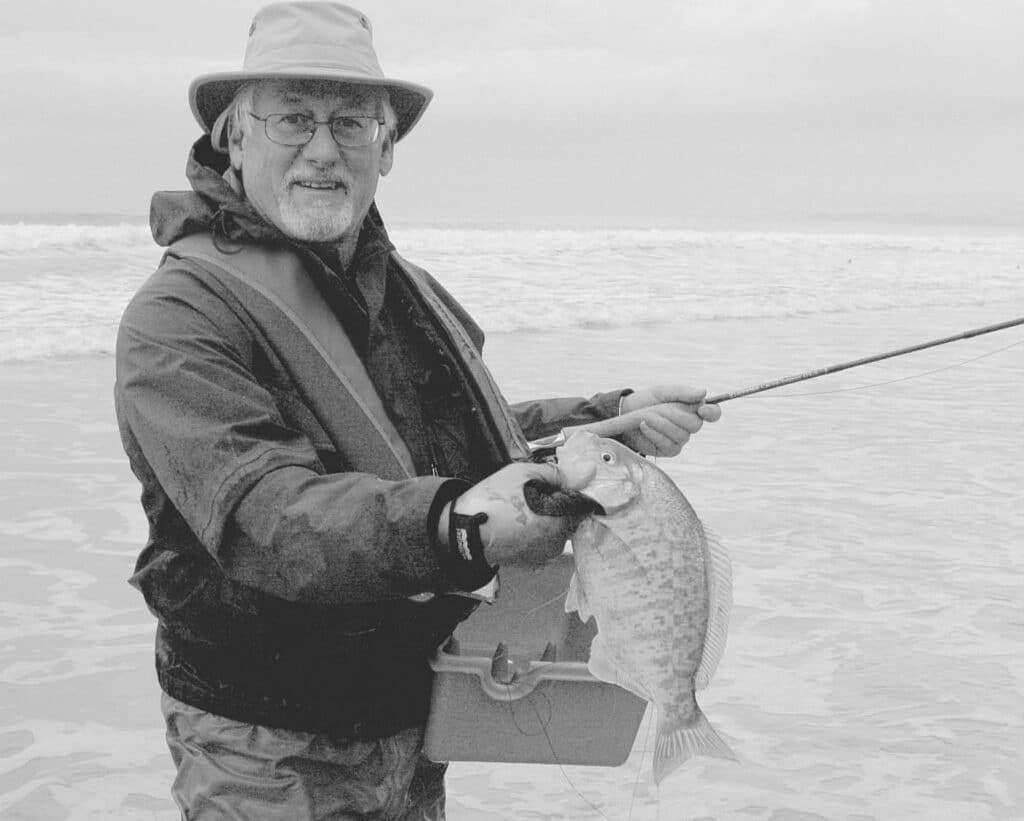
The Heisenberg Compensator
Over the past few years, I have worked on a variety of basket designs aimed at eliminating or counteracting floppy loops. Most prototypes proved to be no better than existing designs. Some were best described as “unconventional.”
Never let it be said that I am afraid to experiment in the name of fly fishing. I can still see Ken Hanley reduced to fits of laughter when I showed up at the beach with one of my more exotic devices. By early 2010, though, I was narrowing in on a design that showed real promise. This prototype was an inverted wire mesh cone. I figured that gravity would tend to funnel line down to a point where the counteracting resistance from line plasticity would make it form a stable layer. As each succeeding section of line was stripped into the cone, it would also be funneled down, forming another stable layer on top of the prior one.
Field testing at a nearby play field confirmed that my gravitational theory had merit. The cone forced the line to lie in a sequential series of stable layers. This significantly reduced the number of standing loops and as a result significantly reduced tangles.
A few iterations later, I had the basic cone design sorted out. I installed a 9-inch-deep by 11-inch-wide cone made from screen door mesh inside a cut-down bucket. The bucket was heavily ventilated and simply acted as a skeleton to support the mesh cone and protect it from deformation caused by wave impact. The cone was a significant improvement, but I noticed I still had a few floppy loops that somehow beat the system. Further observation revealed that tangles usually occurred when an errant loop flopped beyond the central axis of the cone. I figured that if I could hold these loops back, they would be less likely to cause tangles. I played around with a variety of devices. Ultimately, I settled on a simple plastic pipe mounted vertically in the middle of the cone. By installing a central post, most of the loops were stopped in midflop.
I named the new cone-and-postbased basket the Heisenberg Compensator. I shamelessly stole the name from the old 1960s-era TV series Star Trek. In that show, Heisenberg compensators are used in the transporters to overcome Heisenberg’s uncertainty principle. Without getting into the actual physics, the Heisenberg compensators enabled objects to be dematerialized and transported to some distant location, where they would rematerialize in their original state. If lacking compensators, transported objects would rematerialize as atomic mush. The name seemed appropriate, given that my basket was designed to facilitate the transport of line from the basket to the ocean while overcoming small, yet significant, problems with fly-line physics.
I have made some minor improvements to the Heisenberg Compensator, but in most respects, the design I fish today is very close to the original model. I still get occasional tangles, though they are more of an irritation than a full-blown headache these days.
Stripping baskets are an invaluable piece of equipment for most surf-zone fly fishers. Whether you chose one of the retail products or go the DIY route, I assure you they will make the surf experience less complicated. Of course, the main reason for using one is that they make you look really cool.



